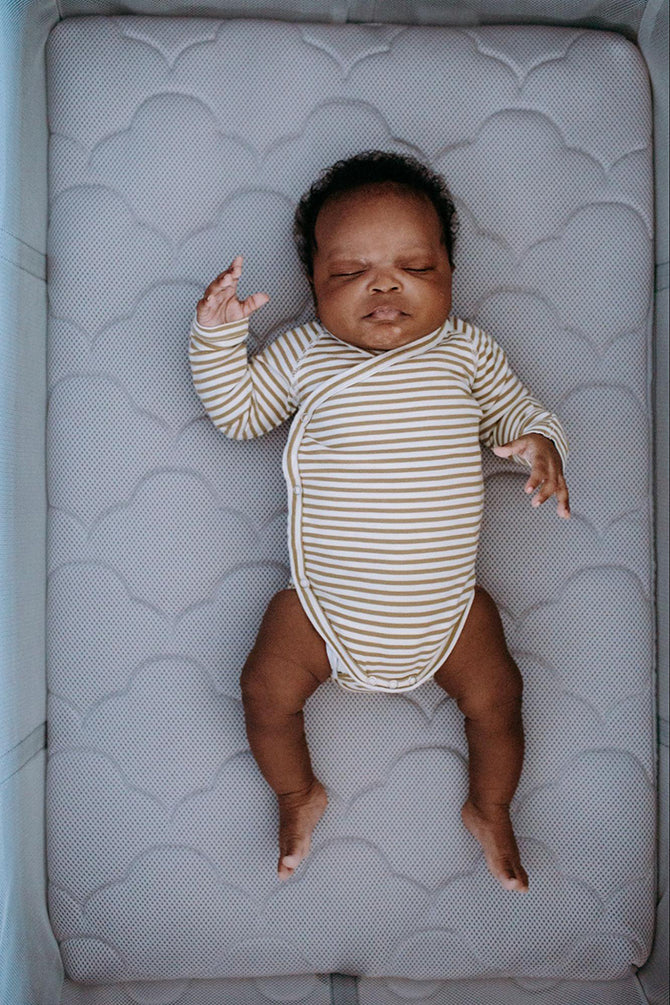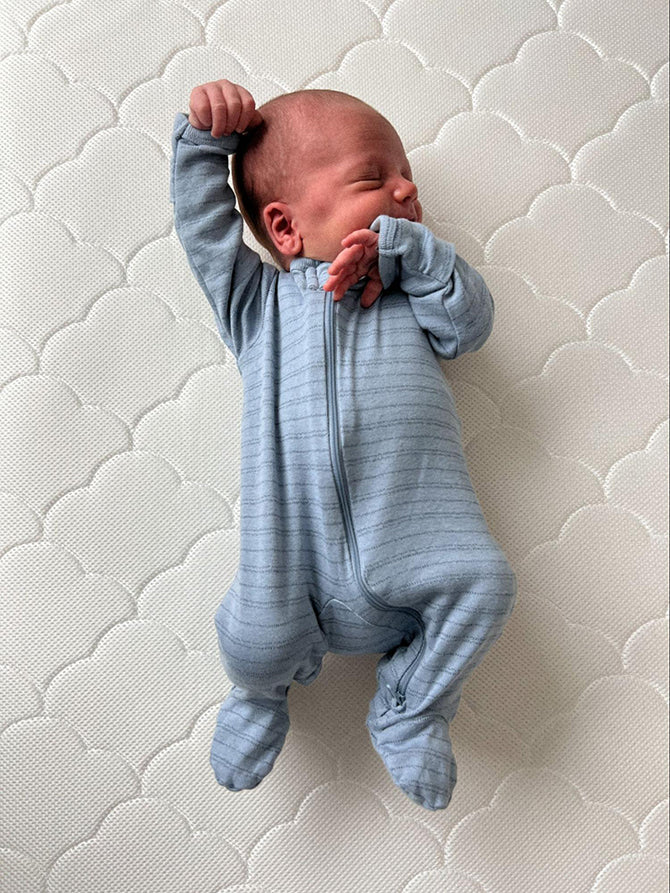
You’ve prepared for the journey of helping your baby sleep through the night. You’re ready. But then you come across a concept you’ve never heard of: a dream feed.
In this article, learn what a dream feed is, how to do it, and if it’s right for you and your baby.
Table Of Contents
- What is dream feeding?
- When can you begin dream feeding?
- Benefits of a dream feed
- Potential risks of a dream feed
- How do you dream feed?
- Why isn’t dream feeding working?
- Getting baby back to sleep
- Sample dream feeding schedule
- When to stop dream feeding
What is dream feeding?
A dream feed is when you feed your baby while they are still sleeping. Sounds confusing, right? But it’s not as tricky as you think.
Dream feeding consists of rousing your baby without fully waking them up before you turn in for the night, typically around 10 p.m. or 11 p.m. Because little ones usually go to bed between 6-8 p.m., they are bound to wake up hungry within a couple of hours, making this the perfect time.
Research has shown that sneaking in a dream feed between 10 p.m. and midnight can reduce the frequency of your little one’s night wakings, which sounds, well, like a dream.
Your baby can be content and full, and you can get your rest without being stirred from sleep for a few precious more hours.
When can you begin dream feeding?

There’s no specific rule as to when you can begin dream feeding — just look for your baby’s cues for this middle-of-the-night meal.
Generally, if your little one is over two months old, has a consistent nighttime feeding schedule, is on track as far as growth is concerned, and doesn’t have trouble falling back asleep when woken, you can give dream feeding a try.
Typically, parents will wait until their baby is sleeping for three or four hours at a stretch before beginning to dream feed, as an extra four hours can make a big difference in extending your nightly rest.
Benefits of a dream feed

Now that you know what a dream feed is, let's talk about its benefits.
One of the best parts of dream feeding is that it doesn’t interfere with your baby’s need to feed at night. Typically, newborns will eat every one to four hours, and by six months, they eat about every four to five hours.
A dream feed simply adjusts their feeding schedule to make it more conducive to your sleep schedule.
This alone could make anyone happy. But there are even more benefits, such as:
- Your baby eating a meal at a convenient time helps you to sleep longer
- Your baby getting the extra calories they need to sleep better
- Your baby waking up less, which can encourage them to eat less throughout the night
- Eating less through the night, which boosts their daytime feedings
- There’s no impact on your milk supply since you’re not skipping feedings
- You will be less sleep deprived, improving your mood and health
Potential risks of a dream feed
To start, dream feeding is considered safe as long as you take your baby out of the crib, wake them up enough to eat, and avoid feeding them while they’re flat on their back. It's best to dream feed your baby in a semi-upright position with their head cradled in the crook of your arm.
But with anything comes a risk or two, and as the attentive parent you are, you probably want to be familiar with the risks of dream feeding. Let’s take a look at some of those risks.
Choking
Just reading this word is scary. But, as we mentioned above, this shouldn’t be an issue if you keep your baby in a semi-upright position while you dream feed.
Over-Feeding
There is the chance that your baby may not even be hungry when you gently rouse them to dream feed. Feeding them anyway could cause them to be overfed.
As a result, they could spit up, get fussy, or increase their dirty diapers overnight, which could then lead to diaper rash.
Middle ear infection
If you are bottle feeding your baby with them on their back, the milk could seep into the Eustachian tubes in their ears and cause an ear infection.
Gas

Chances are, you are no stranger to a gassy baby. But keep in mind that because their digestive systems are immature, little ones tend to swallow air during feedings.
A dream feed can make your baby extra gassy, especially if you aren’t burping them afterward or if burping isn’t effective.
When to call a doctor
There’s no need to fret if your baby isn’t taking to dream feeding. It isn’t required in order for your baby to get a good night’s sleep.
But if you’re interested in trying dream feeding, it doesn’t hurt to ask your pediatrician at your next checkup whether you should incorporate a dream feed into your baby's schedule.
How do you dream feed?

The beauty of a dream feed is that it can help babies stay asleep until a little later in the morning and help mom sleep better. With consistency, this can become part of your little one’s regular sleep schedule.
Even so, timing is everything. Remember you want to maximize your sleep, so helping your baby sync up to a longer overnight sleep stretch can work wonders for both of you.
Also, it’s ideal to dream feed your little one no sooner than two to three hours after they last ate. As we mentioned before, any sooner and they may be too full to take in enough milk for it to have the right effect.
Here are some other things to keep in mind.
1) Dream feed during REM sleep.
It’s fairly easy to spot when your little one is in REM sleep. REM sleep is when you see your baby twitch; move their arms, legs, or fingers; or flutter their eyelids. They sometimes even change their facial expressions.
When you catch your little one in this sleep stage, it’s time to take action on your dream feed so they are more likely to consume enough milk.
2) Take your baby out of the crib or bassinet.
Keep the room dim and quiet and gently pick up your baby. If they don’t wake up, you can slowly unswaddle them, change their diaper, softly sing, or gently massage them.
3) Touch your baby’s cheek with your breast or the bottle.
Performing this action will wake up your baby’s rooting reflex so they can start sucking. Encourage nursing for five to 10 minutes on each side. And for bottle-fed babies, aim for about three ounces.
4) Burp your baby.

We discussed this earlier, but whether your little one has fallen asleep during the dream feed or not, you should always burp them to relieve any potential gas.
Once your baby finishes taking milk and burping, simply place them back in the crib on their back. With any luck, you’ll get an extra three or four hours of needed rest.
Why isn’t dream feeding working?
Try as you may, the whole dream feeding idea is a flop. Maybe your baby still wakes up soon after, fussing or demanding yet another meal. Here are a few things that might be going on.
Baby is too sleepy
Your little one may simply be too tired to think about food. If this is the case, you don’t want to force it — their rest is important too.
Baby is too awake

Your baby may have woken all the way up during the feed and is now ready to stay that way. This is not ideal for you, as you’re ready to hit the sack.
Baby isn’t hungry
Your baby may not be hungry yet and doesn’t have any interest in a dream feed. Take a look at the last time they ate. Maybe you’re giving their last meal too late or this one too early. Adjusting their feeding schedule can help.
Sleep onset association
A sleep onset association is when babies associate sleep with getting a meal.
If your little one is over four months old and only falls asleep while being fed their nighttime meal, when they awaken in the night, they’re going to expect to be fed back to sleep again, even if they’re not hungry.
In this case, a dream feed may not be helpful.
Sleep regressions
Another reason your baby may have a hard time dream feeding is because of a sleep regression. Sleep regressions occur periodically in the first two years as a result of developmental milestones like growth spurts or teething.
Sleep regressions are when your little one, who once was a “good” sleeper, is suddenly fussy and crying through the night or refusing to go to sleep at bedtime.
Sleep regressions typically happen at:
- 4 months
- 6 months
- 8-9 months
- 12 months
- 24 months
Don’t worry, though — sleep regressions are temporary, normally lasting between two and six weeks at a time, although all babies are different.
If you think this is what’s gotten in the way of your dream feeding success, take a break and let baby re-acclimate, and then pick up again.
Getting baby back to sleep
What if your baby won’t fall back asleep? Try some of the pediatrician Harvey Karp’s 5 S’s: swaddle, side-stomach position, shush, swing, and suck.
Swaddle your baby.
If you haven’t already, swaddle your baby. The swaddle, which is basically a large piece of cloth that wraps around your little one like a burrito, helps babies feel comfy and snug.
A swaddle eases a baby’s Moro reflex — that startling feeling of falling when you’re somewhere between being awake and asleep. With their arms and legs tucked safely inside the swaddle, they don’t startle themselves awake.

Swaddles can be used until your baby shows signs that they are learning to roll over. At this point, you’ll want to move to a sleep sack, a wearable blanket that allows babies to be comfortable and safe, as nothing is loose, posing a danger.
Sleep sacks come in different weights, called TOGS. If it’s warmer in the room, choose a lower TOG, and if it’s cooler, choose a higher TOG.
Try a white noise machine.
If your little one is a light sleeper, it can be beneficial to play low white noise all night. This way they won’t wake up to any sounds inside or outside of the house.
When getting your baby back to sleep after a dream feed, you can turn up the volume as you’re putting your little one back down in the crib. The most effective white noise for sleep is continuous, monotonous, and at a low pitch.
Turn down the temperature.
For baby to fall back asleep easily, you want to make sure the room is comfortable, with the Thermostat set to 68 to 72 degrees Fahrenheit. The goal is to keep them comfy and avoid overheating.
Make sure the room is dark.
You don’t want your little one waking up before they need to on account of too much light in their room. Keep the room dark by using blackout curtains in order to maximize their sleep time.
If baby’s room is dry, try a humidifier.
Feeding can be more difficult if your little one’s nose is stuffy. A dry indoor environment can only exacerbate a stuffy nose. If that’s the case, you may want to try a humidifier to add some moisture to the air.
Keep humidity between 30% to 50%, and never exceed 60% or you run the risk of bacteria or mold.
Make sure their mattress is breathable and firm.
If your little one is having a hard time settling after a dream feed, it could be because of the mattress. Be sure their mattress is breathable and firm — two musts for safe sleep.
Breathable mattresses allow for greater airflow, which helps your little one stay comfortable since babies don’t thermoregulate on their own. Your crib mattress should also be firm so that your little one doesn’t sink into it. Soft mattresses pose a suffocation risk.
If you’re in the market for a new mattress, the Newton Baby Essential Crib Mattress is breathable, firm, and even washable. Our mattress features Wovenaire ® technology to maximize airflow and comes with a soft, eyelet removable cover for ultimate comfort.
Top it off with one of our Breathable Organic Sheets, and voila, your baby is ready for safe, sound sleep!
Rock or glide them to sleep.
Another time-tested trick that can help your baby sleep after a dream feed is rocking them in a rocking chair or (for a more modern take on it) gliding back and forth in a glider.
If you don’t have a rocker or glider, you can try walking with your baby in your arms to get them to drift back off to sleep.
Offer a pacifier.
Pacifiers fulfill the sucking need, and research suggests a bedtime paci may help lower the risk of SIDS. If you’re breastfeeding, you might want to wait to start the pacifier until baby has gotten used to nursing.
Here are some tips if you’re going to use a pacifier:
- Only use a pacifier made of one solid piece — two-piece pacifiers can be dangerous
- Don’t use a pacifier that’s connected to any strap
- Be sure to choose a paci that’s the right size for your baby’s age
Always practice safe sleep.

Now that we’re talking about sleep, it’s a good time to make sure you’re up to date on safe sleep practices.
Put baby to sleep on their back.
First, always put your baby to bed on their back, not their side or stomach. This being said, if your little one rolls over in the night, you don’t have to turn them back over, as they will do it themselves.
Only put baby to bed on approved sleep surfaces.
There are only three safe places for your little one to get their shuteye: their crib, travel crib, or bassinet.
If your little one has fallen asleep in their bouncer, swing, on your chest, or anywhere else, you want to move them as soon as possible into their crib.
Say no to bed-sharing, yes to room-sharing.
Although it seems like it’s both cute and convenient, especially when your baby eats so frequently, letting them sleep in your bed is dangerous.
Not only are there blankets and pillows that could pose a suffocation hazard and your mattress is likely not firm enough, but you could accidentally nod off and roll on top of them.
But this doesn’t mean you can’t spend some quality evening hours with your little one. Although bed-sharing is out, room-sharing is highly encouraged.
The American Academy of Pediatrics recommends sharing a room with your baby for at least the first six months and ideally the first year.
Sample dream feeding schedule

Ready to try dream feeding? Here’s a sample schedule to show you what your evening could look like.
6:00 p.m.: Begin your bedtime routine. This can involve feeding and changing your little one, and maybe even a bath, baby massage, or a book. Of course, make sure they’re going to sleep with a full tummy.
9:30 p.m.: Before you turn in, it’s time to dream feed your little one. Given that your baby would be due to wake up soon for a meal anyway, the dream feed will keep them full and content for several more hours.
10:00 p.m.: With baby back to sleep, you can do the same. Sweet dreams!
3:00 a.m.: After you’ve gotten a delightful five hours of sleep, baby awakens for their first meal of the night. That wasn’t so hard!
You have to admit your new dream feed schedule is worlds better than going to sleep only to wake up an hour or two later to feed your sweet (and hungry) little one.
When to stop dream feeding

You’ve gotten so used to dream feeding and are loving it! Your baby (and you) have never slept better. But, eventually, your baby won’t need dream feeds anymore. The good news is as your baby gets older, they’ll start to sleep through the night on their own.
You can usually say goodbye to the dream feed two to four weeks after your baby is sleeping well. Typically, this is when they sleep all the way from dream feeding until morning.
However, age shouldn’t be your only indicator for when to stop dream feeding. Sometimes, dream feeds don’t have the desired outcome.
The goal is to fill your baby up so they’ll sleep longer at night, but as we said, there are times when this could backfire and cause your little one to wake up more often instead. If that’s the case, it’s probably a good idea to stop dream feeding.
Better sleep for you and your baby!

Dream feeding doesn’t work for every baby, but if your little one is a frequent fan of snacking in the middle of the night, it could help you both get a bit more quality shut-eye.
However, it doesn’t work for every baby, so don’t force it. Ultimately, the choice to dream feed is up to you and what works best for your family. If you do decide to try this feeding method, don’t forget to have what you need to lull your little one back to sleep on hand.
With a soothing white noise machine and a firm, breathable mattress by Newton Baby — whether in the Bassinet and Bedside Sleeper, their crib, or our Travel Crib and Playyard — they’ll fall back to sleep safely and securely.
With these tips in mind, you and your little one can become the “dream team” and both get better sleep!
